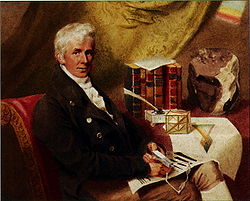James Sowerby
James Sowerby (21 March 1757 – 25 October 1822) was an English naturalist and illustrator. He did the illustration for many published works. English Botany and A Specimen of the Botany of New Holland were especially noteworthy.
James Sowerby | |
|---|---|
 James Sowerby painted by Thomas Heaphy (1816) | |
| Born | 21 March 1757 |
| Died | 25 October 1822 |
| Nationality | English |
| Education | Royal Academy, London |
| Occupation | Illustrator, naturalist, publisher |
| Children | James De Carle, George Brettingham, Charles Edward |
Sowerby was the start of a family business which was carried on for several generations. The Sowerby family became a dynasty of illustrators and natural historians. They lived and worked in the London of the late 18th and the 19th centuries.
James Sowerby first worked with William Curtis, whose Flora Londinensis he illustrated. Early volumes of the first British botany journal, The Botanical Magazine (edited by Curtis), contained seventy of his illustrations.
In 1790, he began the first of several huge projects: a 36-volume work on English Botany which was published over the next 24 years. It contained 2592 hand-colored engravings and became known as "Sowerby's Botany".
A huge number of plants got their first formal publication here. The text, unattributed, was written by James Edward Smith.[1] Sowerby set out to supplement English Botany with his own text and descriptions of Coloured figures of English fungi or mushrooms, 4 vols.
A Specimen of the Botany of New Holland was written by James Edward Smith and illustrated by James Sowerby. It was the first monograph on the flora of Australia. It was intended to meet "the general interest in, and propagation of, the flowering species of the new antipodean colonies". Sowerby's own hand coloured engravings, based upon original sketches and specimens brought to England, were both descriptive and striking.
Sowerby's detailed and appealing plates in vivid colour and readable texts were intended to reach a growing readership interested in natural history.
James Sowerby Media
Hand-coloured print from an engraving of Banksia spinulosa from A Specimen of the Botany of New Holland by Sowerby
Cassiterite from Cornwall, from British Mineralogy, 1803
References
- ↑ Walsh, Huber M. (2003). "James Sowerby". Rare book - Authors. Missouri Botanical Garden. Archived from the original on 2007-09-27. Retrieved 2007-07-26.
Unlike other flower painters of the time, whose work tended toward pleasing wealthy patrons, he worked directly with scientists.


